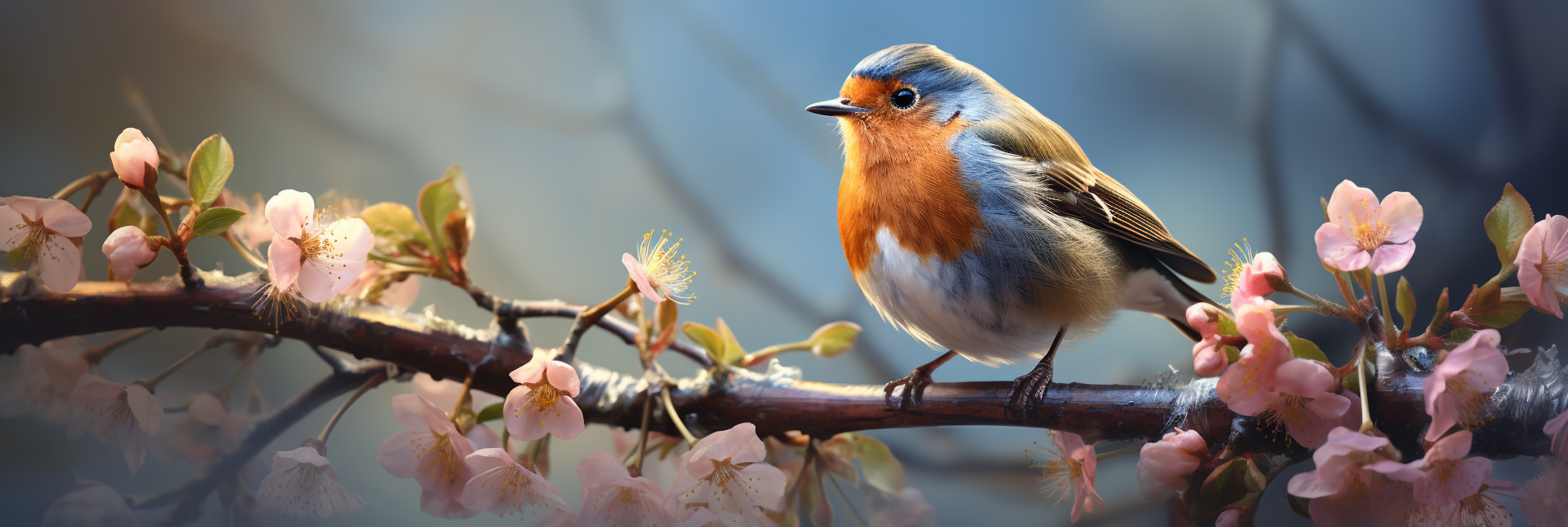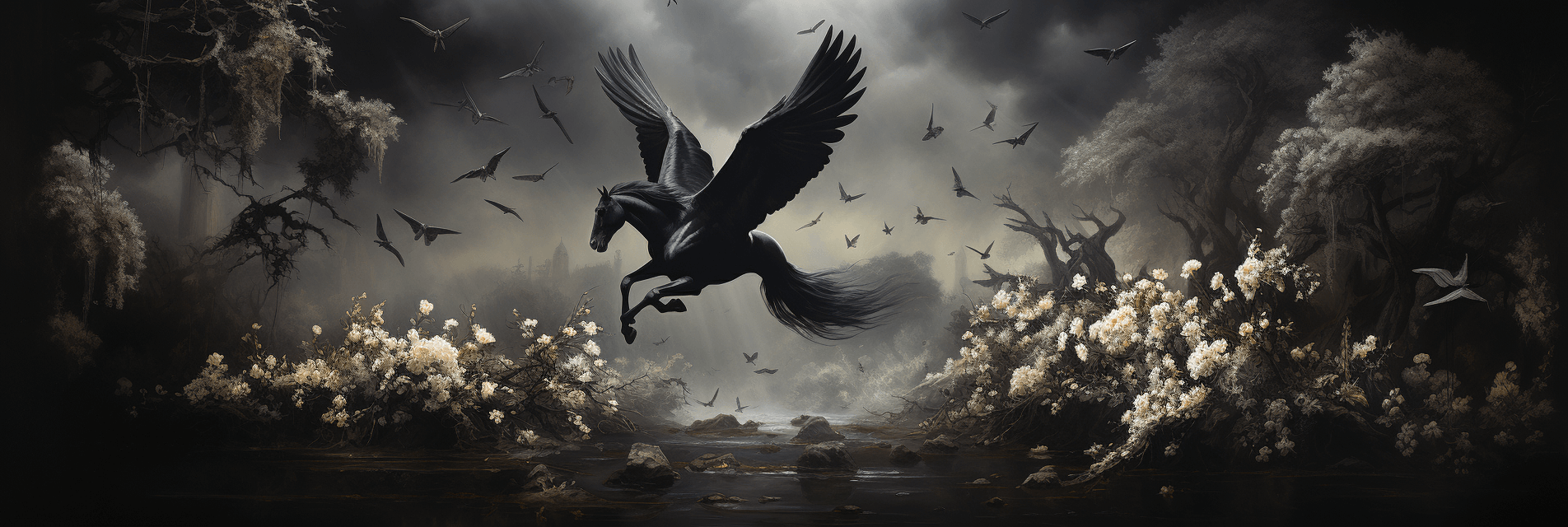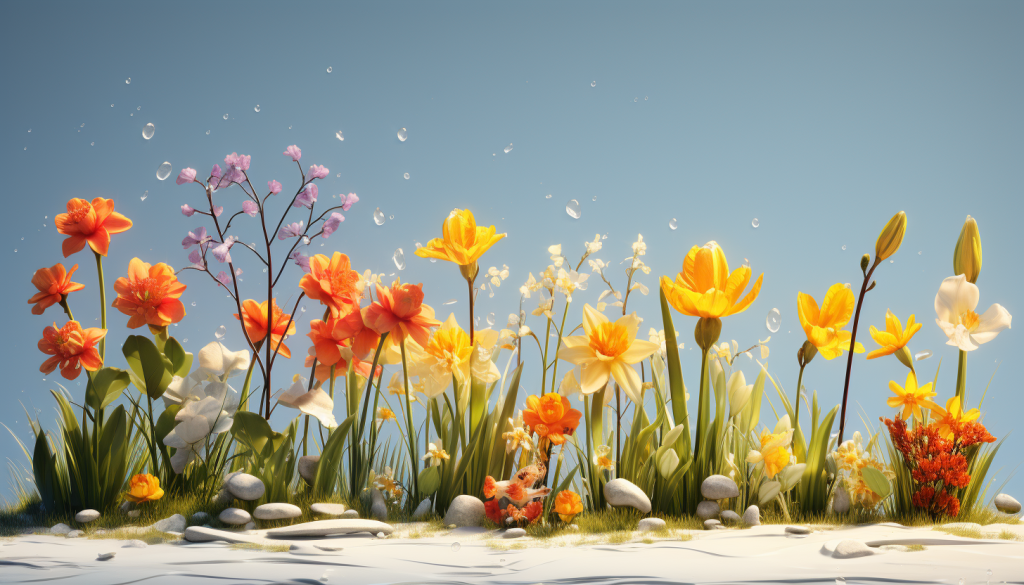Table of Contents
- Blossoms of Renewal: The Significance of Spring Flowers
- Equinox Euphoria: The Magic of the Spring Equinox and Its Rituals
- Creatures of Regrowth: Animals Signifying Spring’s Revival
- Festivals of Awakening: Spring Celebrations Across Cultures
- The Maiden of Growth: Mythological Figures and Legends of Spring
- Shades of Life: Deciphering Spring’s Vibrant Colors
Blossoms of Renewal: The Significance of Spring Flowers
Spring bursts forth in a mosaic of colors, a visual feast for those weary of winter’s grey palette. But beyond their captivating beauty, spring flowers bear deep-rooted significance and stories. Let’s delve into the wonders of these blossoms and uncover the tales they hold within their petals.
-
Cherry Blossoms: Brief Beauty and the Transience of Life
The cherry blossom, or sakura in Japanese, stands as a symbol of life’s fleeting nature. This flower’s brief blooming period is a gentle reminder to cherish every moment. The Japanese have long celebrated the sakura season with hanami – flower viewing picnics and gatherings beneath the blossom-laden trees.
-
Daffodils: Rebirth and New Beginnings
Marking their arrival with bold yellows and whites, daffodils are often associated with rebirth and new beginnings. They are commonly linked to the Greek myth of Narcissus, a tale of beauty, reflection, and transformation. In modern times, the daffodil serves as an emblem of hope and is recognized internationally as a symbol of cancer awareness.
-
Tulips: A Love That’s Eternal
The tulip, originating from the Turkish lands and cherished in the Netherlands, carries a message of deep love and passion. It’s believed that the flower’s velvety black center represents a lover’s heart, darkened by the heat of passionate love. Various colors of tulips also bear unique meanings: red for true love, purple for royalty, and white for forgiveness.
-
Bluebells: Humility and Everlasting Love
Carpeting woodlands with their delicate blue hues, bluebells are often linked to humility due to their bowed heads. Old tales whisper that a field of bluebells is intricately woven with fairy enchantments, making it a magical but dangerous place to be. Their perennial reappearance symbolizes constancy and everlasting love.
-
Lilacs: Youthful Innocence and Confidence
The sweet scent of lilacs heralds the onset of warmer days. These fragrant blooms, in their purples and whites, speak of youthful innocence, memories, and confidence. It’s said that a bouquet of lilacs can bring back fond memories and even rekindle old love.
In wrapping up our fragrant journey through the spring garden, one thing is clear: each flower is a storyteller, narrating tales of love, life, and transformation. So the next time you walk amidst spring’s bloom, remember, there’s more than just color meeting the eye; there’s a universe of stories waiting to be discovered.
Equinox Euphoria: The Magic of the Spring Equinox and Its Rituals
With the world slowly waking from winter’s slumber, the Spring Equinox marks a powerful point of balance in our celestial journey. It’s a moment when day and night stand in equal measure, foreshadowing the promise of warmer days and vibrant life ahead. But what lies behind this significant day, and how have civilizations past and present celebrated it?
Origins: A Celestial Balance
The term ‘equinox’ stems from the Latin words ‘aequus’ (equal) and ‘nox’ (night). True to its name, it signifies the period when daylight and nighttime are approximately the same length. For many, it’s not just an astronomical event but a deep-rooted symbol of balance, renewal, and fresh beginnings.
The Ostara Festivity
Long before modern traditions, ancient pagans recognized the equinox with the festival of Ostara. Celebrated as a day of balance, it was also the time to welcome fertility and growth. Symbols like eggs and hares were prominent, representing birth and proliferation. Sound familiar? It’s no surprise that these very symbols have trickled down to our modern-day Easter celebrations!
Stonehenge: The Alignment Mystery
One of the world’s most renowned landmarks, Stonehenge in England, holds mysteries tied to the equinoxes. During the Spring Equinox, the sun rises perfectly in alignment with the Stonehenge stones, casting a mesmerizing spectacle. While the exact purpose remains a subject of debate, many believe it was a site for spiritual ceremonies aligned with celestial events.
Modern Celebrations
Today, the Spring Equinox is celebrated in multifarious ways across the globe. From the Higan celebrations in Japan, where people visit family graves, to the colorful festival of Holi in India, heralding the victory of good over evil with vibrant dyes. The essence, though varied, remains the same—embracing new beginnings and celebrating life’s resurgence.
Creatures of Regrowth: Animals Signifying Spring’s Revival

As spring unfurls its tender green shoots, the animal kingdom too begins its dance of rejuvenation. From the first robin’s song to the flutter of butterfly wings, animals play a central role in signifying spring’s revival. Their behaviors, migrations, and very presence are deeply intertwined with the season’s themes of rebirth, growth, and hope.
The Robin: Harbinger of Spring
One of the most iconic symbols of spring’s onset is the cheerful song of the robin. With its vibrant red breast, this bird is often considered a messenger of hope. Its song, echoing the promise of new beginnings, is a melodious reminder that warmer days are approaching.
Lambs and the Promise of Life
The playful antics of lambs, frolicking in meadows, encapsulate the youthful spirit of spring. They are not just cute additions to the landscape but symbolize purity, innocence, and the continuous cycle of life. Their births herald the season of growth and abundance.
Butterflies: Metamorphosis and Transformation
- Monarch Butterfly: Known for its epic migration, the return of this orange and black beauty signals warmer days.
- Painted Lady: This butterfly’s journey from caterpillar to chrysalis and then to winged wonder is emblematic of transformation, a key theme of spring.
Amphibians’ Evening Serenade
Have you ever paused to listen to the chorus of frogs and toads on a spring evening? These amphibians, especially the spring peeper, with its high-pitched call, signify the wetlands and ponds coming alive after winter’s freeze. Their evening melodies are a celebration of life’s persistence.
In the grand tapestry of nature, each animal, with its unique behavior and presence, adds to the narrative of spring’s revival. They teach us about resilience, the beauty of change, and the cyclical nature of life. So, the next time you spot a robin or hear the distant croak of a frog, take a moment to appreciate the intricate symbols and stories of spring they bring with them.
Festivals of Awakening: Spring Celebrations Across Cultures
Spring, with its vibrant colors and renewed life, isn’t just a season; it’s a global celebration. Across continents and cultures, communities come together to revel in the joy of nature’s rebirth. While the customs may differ, the essence remains the same: to honor the resurrection of life, to welcome the warmth, and to bid adieu to the cold shadows of winter. Let’s embark on a journey to explore some of these springtime festivities.
Holi: The Festival of Colors
Originating in India, Holi is a boisterous celebration filled with vibrant hues, melodious songs, and joyous dancing. Participants throw colored powders at each other, symbolizing the playfulness of spring and the victory of good over evil. It’s a time of forgiveness, merriment, and a fresh start.
Cherry Blossom Festivals
In Japan, the bloom of cherry blossoms, or sakura, is eagerly anticipated. Hanami, or ‘flower viewing’, is an age-old tradition where people picnic under these pink canopies. The ephemeral nature of the blossoms serves as a reminder of the fleeting nature of life, urging one to appreciate its transient beauty.
Easter: Renewal and Resurrection
Marked around the world, especially in Christian communities, Easter symbolizes the resurrection of Jesus Christ. Traditions like the Easter egg hunt and the Easter bunny have their roots in pagan celebrations of spring and fertility, which were integrated into Christian customs.
Nowruz: Persian New Year
Celebrated on the spring equinox, Nowruz signifies new beginnings in various countries, including Iran, Afghanistan, and Central Asian nations. Families gather around the Haft-Seen table, which is adorned with seven symbolic items, each beginning with the Persian letter ‘S’. These items, ranging from apples to garlic, represent different facets of life and nature.
In the mosaic of global festivities, each festival, with its unique traditions and rituals, contributes to the collective celebration of spring’s revival. They remind us that no matter where we come from, the joy of spring and the promise of renewal is a universal sentiment, cherished by all.
The Maiden of Growth: Mythological Figures and Legends of Spring

Mythology has always played a pivotal role in helping societies understand and interpret the natural world around them. Spring, with its blossoming beauty and promise of new life, has been a recurrent theme in legends across various cultures. Central to these myths are deities and figures who embody the spirit of spring. Through their tales, we gain insight into how different cultures perceive and revere this rejuvenating season.
Spring Deities Across Cultures
Here’s a brief table illustrating some of the most iconic figures associated with spring from different mythologies around the world:
| Deity/Figure | Culture | Attributes and Significance |
|---|---|---|
| Persephone | Greek | Goddess of vegetation who spends half the year in the Underworld, causing autumn and winter, and returns in spring, bringing life back to Earth. |
| Ostara | Germanic | Associated with the dawn and the renewal of life, this goddess gave her name to the festival of Easter. She’s often depicted with hares, an animal symbolizing fertility. |
| Flora | Roman | Goddess of flowers and blossoms, she was honored during the Floralia festival, filled with games, dancing, and flowers. |
| Chun Zi (春子) | Chinese | Often represented as a young maiden, she signifies the onset of spring, freshness, and rejuvenation. |
These mythological figures, though stemming from different cultural backgrounds, bear testament to the universal human tendency to personify the forces of nature. Through their tales of love, loss, renewal, and rebirth, they beautifully encapsulate the essence of spring – a season of unparalleled vitality and hope.
Shades of Life: Deciphering Spring’s Vibrant Colors
The advent of spring brings a riot of colors to landscapes across the globe. From delicate pastels to vibrant hues, the palette of spring carries with it a multitude of messages and significances. But what do these colors truly signify? Let’s dive into the heart of spring’s chromatic display and decipher the meanings embedded in its colors.
Pastel Pinks and Whites
One of the first harbingers of spring, cherry blossoms grace many landscapes with their pastel pinks and whites. These colors often symbolize purity, innocence, and a fresh start. They embody the essence of new beginnings, akin to the clean slate that spring offers to the world.
Lush Greens
As trees sprout new leaves and grasses grow, green becomes the dominant color of the season. It’s no wonder that green stands for renewal and growth. This color also indicates fertility and the earth’s revitalized energy after the long winter slumber.
Radiant Yellows
Fields of daffodils and tulips, bright yellow canaries flitting about, and the sun reclaiming its hold in the sky—all paint spring in shades of yellow. This effervescent color symbolizes joy, happiness, and the warmth of the season.
Brilliant Blues
With the onset of spring, clear blue skies become more frequent. This azure expanse speaks of clarity, tranquility, and the infinite possibilities that the season holds. It’s a reminder of nature’s vastness and the serenity it offers.
- The Interplay of Colors: More than just a visual treat, the interplay of colors in spring reflects the dynamism of life. The blend of different hues on a single canvas showcases nature’s diversity and its ability to harmonize contrasting elements.
- Emotions and Colors: Spring’s colors don’t just represent physical phenomena; they resonate with our emotions. The freshness of green, the enthusiasm of yellow, the calmness of blue—all evoke specific feelings and set the mood for the season.
Spring is nature’s way of celebrating life. Every shade and tint that it unfurls holds a story, a message, and an emotion. So, the next time you find yourself amidst spring’s vibrant tapestry, take a moment to reflect on the colors. They might just have something profound to tell you.
Frequently Asked Questions
What are the most prominent colors associated with spring?
Spring is often associated with a variety of vibrant colors. Prominent among these are pastel shades like pink, lavender, and sky blue, along with fresh green hues representing new growth and renewal. The blossoming flowers of spring, such as cherry blossoms, tulips, and daffodils, contribute to this colorful palette.
Why do cherry blossoms symbolize new beginnings?
Cherry blossoms are one of the first flowers to bloom as winter transitions to spring. Their brief appearance and delicate beauty symbolize the fleeting nature of life. In many cultures, especially in Japan, they represent new beginnings, hope, and the ephemeral nature of existence, reminding us to appreciate the present moment.
How does green in spring differ from the greens of other seasons?
The green of spring is a fresh, vibrant hue that represents new growth and rebirth. Compared to the deeper, mature greens of summer or the muted, fading greens of autumn, spring’s green is often lighter and more tender, evoking a sense of renewal and optimism.
What emotions are commonly evoked by spring’s color palette?
Spring’s color palette, with its fresh greens, soft pastels, and bright blossoms, often evokes feelings of joy, hope, and rejuvenation. These colors can uplift the spirit, signify renewal and growth, and inspire a sense of optimism and anticipation for the warmer months ahead.
Are there specific flowers that are significant to spring’s color symbolism?
Yes, several flowers are significant to spring’s color symbolism. Daffodils, with their bright yellow hues, symbolize rebirth and new beginnings. Tulips, available in a range of colors, stand for love and the arrival of spring. Lilacs represent first love and the early emotions of youth, while cherry blossoms, as mentioned, signify the transient nature of life and new beginnings.
Why is spring often associated with renewal and rebirth?
Spring follows the dormancy of winter, bringing longer days, warmer temperatures, and the resurgence of flora and fauna. It symbolizes the cycle of life, where after every ending comes a new beginning. This season, with its fresh sprouts and blooming flowers, naturally evokes feelings of renewal and the start of a new phase in nature’s cycle.
How do cultural celebrations in spring relate to nature’s symbols?
Many cultural celebrations in spring are deeply rooted in nature’s symbols. For instance, Easter eggs symbolize fertility and rebirth, while Holi, the festival of colors, celebrates the vibrant hues of spring and the victory of good over evil. Such festivals often mirror the rejuvenating energy of nature during this season.
Are there any animals specifically associated with spring symbolism?
Indeed, several animals are linked with spring symbolism. Rabbits, with their notable reproductive rate, symbolize fertility. Birds, especially those that migrate, mark the arrival of spring as they return to their nesting grounds. Butterflies, transitioning from caterpillars, exemplify transformation and new beginnings.
How have ancient myths and legends shaped our perception of spring?
Ancient myths and legends often centered around the themes of renewal and rebirth, which are emblematic of spring. For instance, in Greek mythology, the story of Persephone’s return from the underworld heralds the onset of spring and the revival of vegetation. Such stories have deeply influenced our cultural and symbolic understanding of the season.
Why do some people consider spring to be a time of romance and love?
Spring, with its blossoming flowers, chirping birds, and gentle warmth, creates an ambiance of renewal and rejuvenation. Nature is vibrant and full of life, which can evoke feelings of joy and optimism. These favorable conditions and the natural beauty of the season often inspire romantic sentiments, making it a time associated with love and connection.

